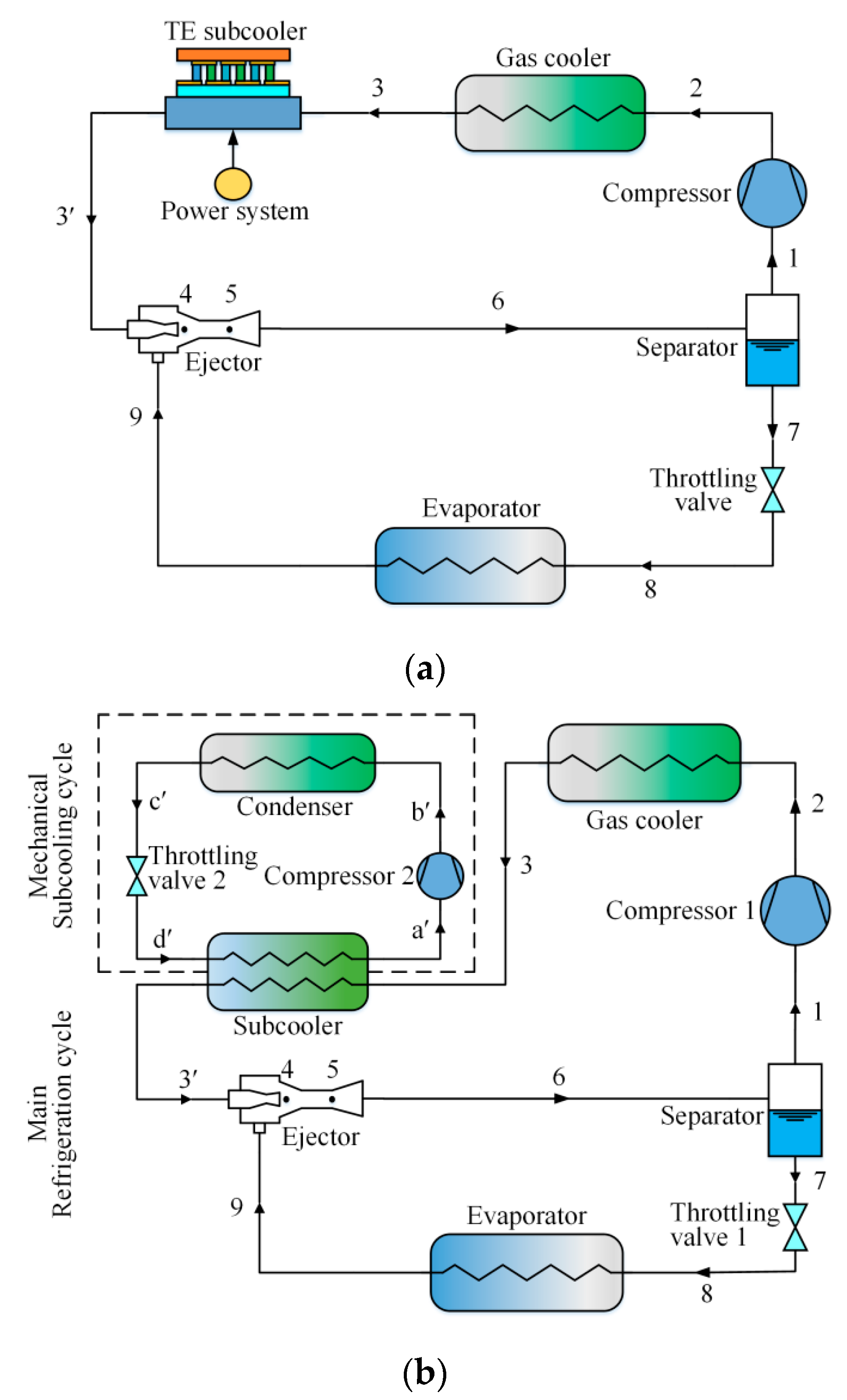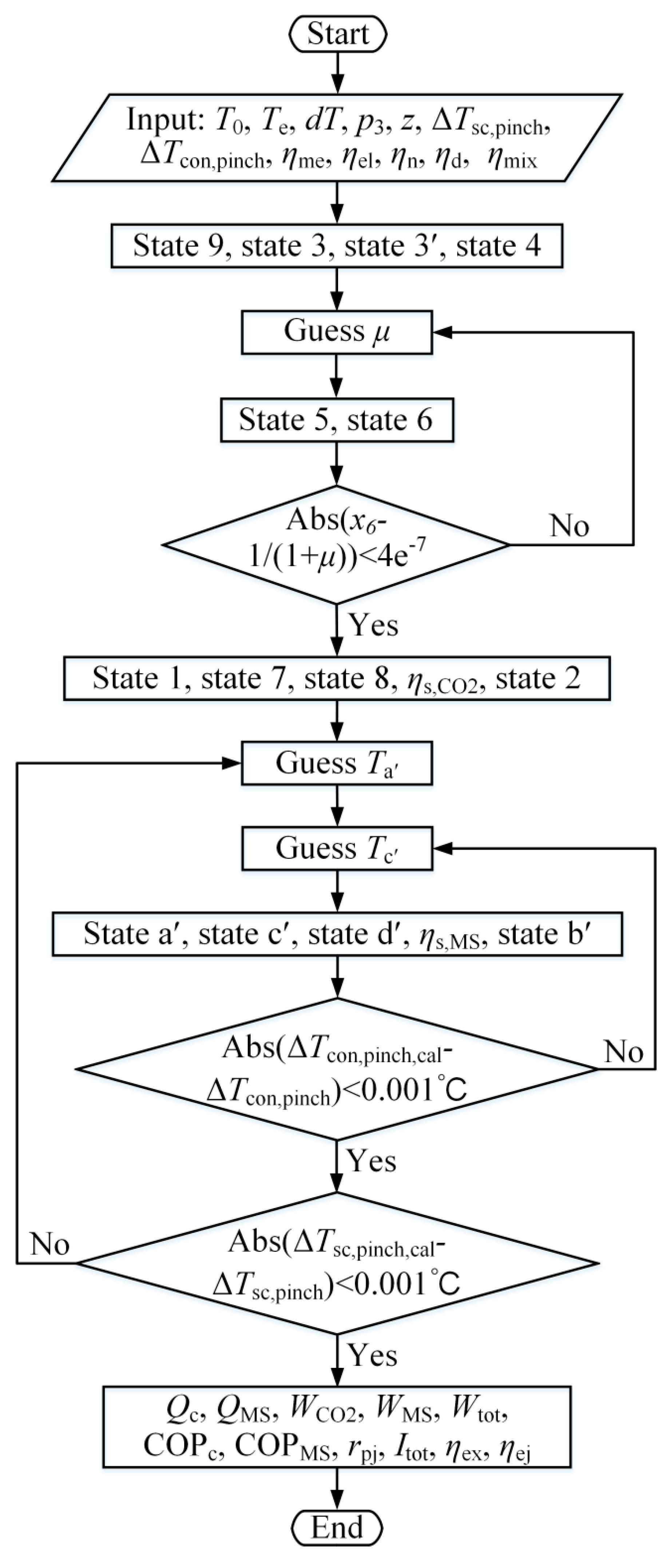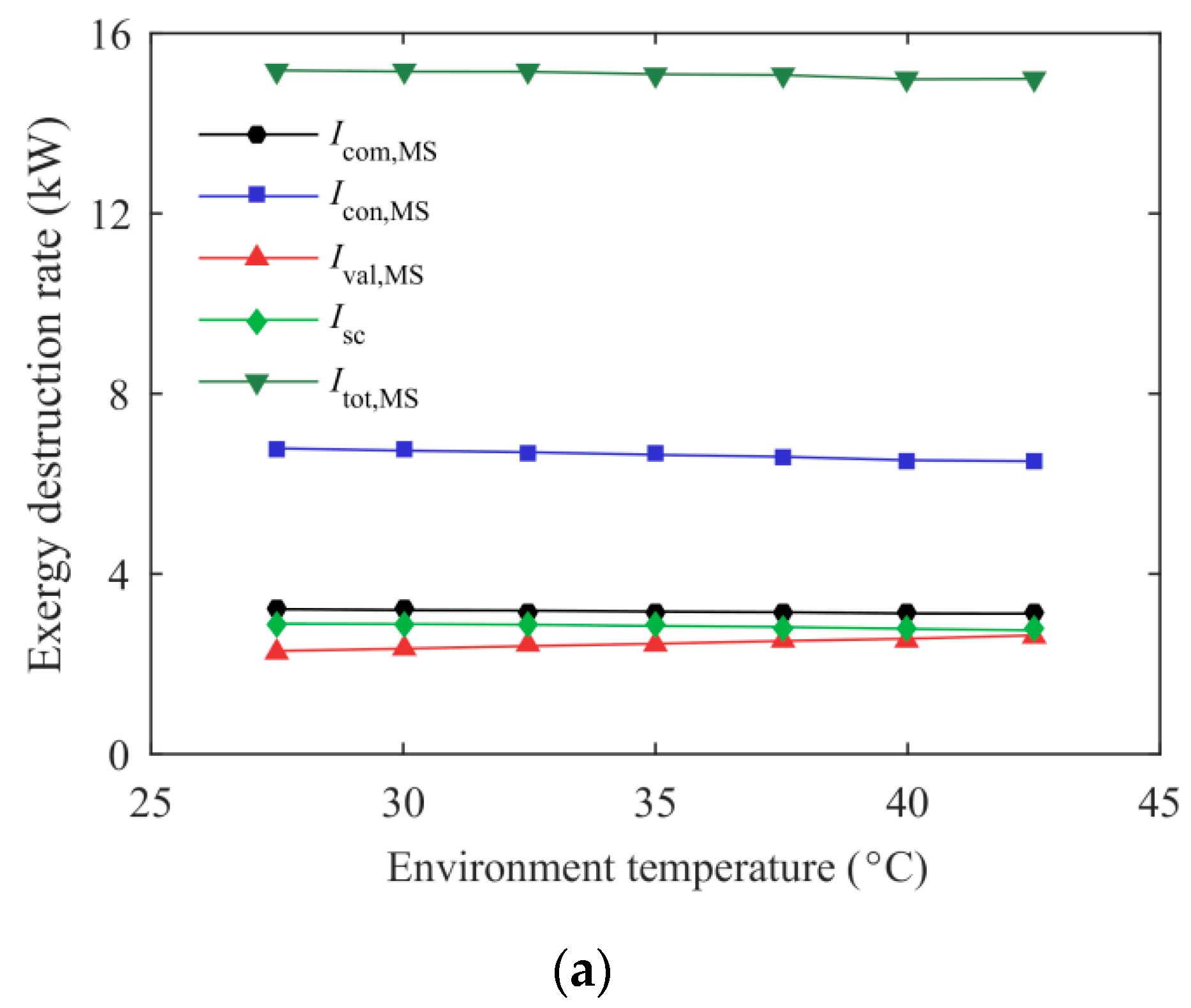Thermodynamic Analysis of Transcritical CO2 Ejector Expansion Refrigeration Cycle with Dedicated Mechanical Subcooling
Abstract
1. Introduction
2. Cycle Description and Simulation Model
2.1. Cycle Description
2.2. Simulation Model
2.2.1. Assumption of the Model
- (1)
- The cycle operates at a steady state and the flow in the ejector is one-dimensional.
- (2)
- The heat losses and pressure drops in the pipelines and heat exchangers are negligible.
- (3)
- In the CO2 cycle, the outgoing flows of the evaporator and separator are saturated. In the mechanical subcooling cycle, the refrigerants leaving the subcooler and condenser are saturated.
- (4)
- The primary and secondary flows are mixed at constant pressure. The inlet and outlet velocities in the ejector are neglected.
- (5)
- The ejector efficiencies are assumed as constant values. The mechanical efficiency and electrical efficiency of the compressors are constant, and their isentropic efficiency is the expression of pressure ratio.
- (6)
- The gas cooler, subcooler, condenser, and evaporator are counter-flow heat exchangers.
2.2.2. Ejector Model
2.2.3. Energetic Analysis
2.2.4. Exergetic Analysis
2.2.5. Solving Procedure
- (1)
- The properties at points 9, 3, and 3′ can be obtained based on environmental temperature, evaporation temperature, discharge pressure and subcooling degree. The properties at point 4 are calculated through nozzle efficiency and evaporation pressure.
- (2)
- The entrainment ratio is assumed.
- (3)
- The properties at point 5 are calculated according to Equations (5)–(8) and evaporation pressure. Based on the energy conservation and given diffuser efficiency, the properties at point 6 are obtained.
- (4)
- If the condition is not met, μ is re-assumed and step (3) is executed again.
- (5)
- The properties of points 1, 7, 8, and 2 are calculated.
- (6)
- Ta′ and Tc′ are assumed.
- (7)
- The properties of points a′, c′, d′, and b′ are calculated according to the mass fraction of R32 and the assumed Ta′ and Tc′.
- (8)
- If the absolute deviation between the calculated pinch temperature difference of the condenser and the specified value is greater than 0.001 °C, Tc′ is re-assumed and step (7) is performed.
- (9)
- If the condition is not satisfied, steps (6)–(8) will be repeated until this condition met.
- (10)
- Performance parameters for evaluating the EMS cycle are calculated using the above equations.
3. Simulation Results and Discussion
3.1. The Optimum Operating Condition
3.2. Effect of Environmental Temperature
3.3. Effect of Evaporation Temperature
4. Conclusions
- (1)
- A maximum COPc was achieved for the ETS and the EMS cycles with a simultaneous optimization of subcooling degree and discharge pressure. The EMS cycle showed a higher optimum subcooling degree, and a lower optimum discharge pressure was obtained when the mixed refrigerant with a proper mass ratio was selected in the MS cycle.
- (2)
- The new proposed EMS cycle performed well in terms of the ejector performance, the system energetic and exergetic performance. Taking the EMS (0.6/0.4) cycle as an example, the maximum COPc was enhanced by 10.27% and the improvement in the system exergy efficiency was up to 15.56% compared with the ETS cycle at T0 = 35 °C and Te = −5 °C. Additionally, a 23.19% increment in Qc and a 21.82% enhancement in ηej were also obtained in this condition.
- (3)
- It is recommended to apply the new cycle in warm and hot regions, where the improvements in COPc and ηex were more obvious.
- (4)
- It is necessary to select a proper mass ratio of the mixed refrigerant in the mechanical subcooling cycle according to different working conditions.
Author Contributions
Funding
Acknowledgments
Conflicts of Interest
Nomenclature
| dT | subcooling degree (°C) |
| ex | specific exergy (kJ kg−1) |
| h | specific enthalpy (kJ kg−1) |
| I | exergy destruction rate (kW) |
| m | mass flow rate (kg s−1) |
| p | pressure (MPa) |
| q | specific cooling capacity (kJ kg−1) |
| Q | cooling capacity (kW) |
| rpj | pressure lifting ratio of ejector |
| s | specific entropy (kJ kg−1 K−1) |
| T | temperature (°C) |
| u | velocity (m s−1) |
| W | power (kW) |
| x | quality (%) |
| z | mass fraction of R32 |
| Greek symbols | |
| η | efficiency (%) |
| μ | entrainment ratio |
| Subscripts | |
| 0 | environment |
| 1-9, 3′, a′-d′ | state point |
| c | cooling |
| cal | calculated |
| com | compressor |
| con | condenser |
| d | diffuser |
| e | evaporation |
| ej | ejector |
| el | electrical |
| eva | evaporator |
| ex | exergy |
| gc | gas cooler |
| me | mechanical |
| mix | mixing chamber |
| MS | mechanical subcooling cycle |
| n | nozzle |
| opt | optimum |
| s | isentropic |
| sc | subcooler |
| sp | separator |
| tot | total |
| TS | thermoelectric subcooling system |
| val | throttling valve |
| Acronyms | |
| COP | coefficient of performance |
| EMS | the transcritical CO2 ejector expansion refrigeration cycle with a dedicated mechanical subcooling cycle |
| ETS | the transcritical CO2 ejector expansion refrigeration cycle with a thermoelectric subcooling system |
| GWP | global warming potential |
| ODP | ozone depletion potential |
| TE | thermoelectric |
References
- Lorentzen, G.; Pettersen, J. A new, efficient and environmentally benign system for car air-conditioning. Int. J. Refrig. 1993, 16, 4–12. [Google Scholar] [CrossRef]
- Lorentzen, G. Revival of carbon dioxide as a refrigerant. Int. J. Refrig. 1994, 17, 292–301. [Google Scholar] [CrossRef]
- Gullo, P.; Hafner, A.; Banasiak, K. Transcritical R744 refrigeration systems for supermarket applications: Current status and future perspectives. Int. J. Refrig. 2018, 93, 269–310. [Google Scholar] [CrossRef]
- Liu, F.; Groll, E.A. Study of ejector efficiencies in refrigeration cycles. Appl. Therm. Eng. 2013, 52, 360–370. [Google Scholar] [CrossRef]
- Kim, M.H.; Pettersen, J.; Bullard, C.W. Fundamental process and system design issues in CO2 vapor compression systems. Prog. Energy Combust. Sci. 2004, 30, 119–174. [Google Scholar] [CrossRef]
- Tian, H.; Ma, Y.T.; Li, M.X.; Wang, W. Study on expansion power recovery in CO2 trans-critical cycle. Energy Convers. Manag. 2010, 51, 2516–2522. [Google Scholar] [CrossRef]
- Sarkar, J. Ejector enhanced vapor compression refrigeration and heat pump systems—A review. Renew. Sustain. Energy Rev. 2012, 16, 6647–6659. [Google Scholar] [CrossRef]
- Sumeru, K.; Nasution, H.; Ani, F.N. A review on two-phase ejector as an expansion device in vapor compression refrigeration cycle. Renew. Sustain. Energy Rev. 2012, 16, 4927–4937. [Google Scholar] [CrossRef]
- Sun, Z.; Li, M.; Han, G.; Ma, Y. Performance study of a transcritical carbon dioxide cycle with an expressor. Energy 2013, 60, 77–86. [Google Scholar]
- Zhang, Z.; Tong, L.; Wang, X. Thermodynamic analysis of double-stage compression transcritical CO2 refrigeration cycles with an expander. Entropy 2015, 17, 2544–2555. [Google Scholar] [CrossRef]
- Zhu, Y.; Li, C.; Zhang, F.; Jiang, P.X. Comprehensive experimental study on a transcritical CO2 ejector-expansion refrigeration system. Energy Convers. Manag. 2017, 151, 98–106. [Google Scholar] [CrossRef]
- Zheng, L.X.; Deng, J.Q.; Zhang, Z.X. Dynamic simulation of an improved transcritical CO2 ejector expansion refrigeration cycle. Energy Convers. Manag. 2016, 114, 278–289. [Google Scholar] [CrossRef]
- Zhang, Z.Y.; Ma, Y.T.; Wang, H.L.; Li, M.X. Theoretical evaluation on effect of internal heat exchanger in ejector expansion transcritical CO2 refrigeration cycle. Appl. Therm. Eng. 2013, 50, 932–938. [Google Scholar] [CrossRef]
- Nebot-Andres, L.; Llopis, R.; Sanchez, D.; Catalan-Gil, J.; Cabello, R. CO2 with mechanical subcooling vs. CO2 cascade cycles for medium temperature commercial refrigeration applications thermodynamic analysis. Appl. Sci. 2017, 7, 955. [Google Scholar]
- Park, C.; Lee, H.; Hwang, Y.H.; Radermacher, R. Recent advances in vapor compression cycle technologies. Int. J. Refrig. 2015, 60, 118–134. [Google Scholar] [CrossRef]
- Bai, T.; Yan, G.; Yu, J.L. Thermodynamics analysis of a modified dual-evaporator CO2 transcritical refrigeration cycle with two-stage ejector. Energy 2015, 84, 325–335. [Google Scholar] [CrossRef]
- Perez-Garcia, V.; Rodriguez-Munoz, J.L.; Ramirez-Minguela, J.J.; Belman-Flores, J.M.; Mendez-Diaz, S. Comparative analysis of energy improvements in single transcritical cycle in refrigeration mode. Appl. Therm. Eng. 2016, 99, 866–872. [Google Scholar] [CrossRef]
- Deng, J.Q.; Jiang, P.X.; Lu, T.; Lu, W. Particular characteristics of transcritical CO2 refrigeration cycle with an ejector. Appl. Therm. Eng. 2007, 27, 381–388. [Google Scholar] [CrossRef]
- Bai, T.; Yu, J.L.; Yan, G. Advanced exergy analyses of an ejector expansion transcritical CO2 refrigeration system. Energy Convers. Manag. 2016, 126, 850–861. [Google Scholar] [CrossRef]
- Lucas, C.; Koehler, J. Experimental investigation of the COP improvement of a refrigeration cycle by use of an ejector. Int. J. Refrig. 2012, 35, 1595–1603. [Google Scholar] [CrossRef]
- Lee, J.S.; Kim, M.S.; Kim, M.S. Experimental study on the improvement of CO2 air conditioning system performance using an ejector. Int. J. Refrig. 2011, 34, 1614–1625. [Google Scholar] [CrossRef]
- Li, D.Q.; Groll, E.A. Transcritical CO2 refrigeration cycle with ejector-expansion device. Int. J. Refrig. 2005, 28, 766–773. [Google Scholar] [CrossRef]
- Llopis, R.; Nebot-Andres, L.; Sanchez, D.; Catalan-Gil, J.; Cabello, R. Subcooling methods for CO2 refrigeration cycles: A review. Int. J. Refrig. 2018, 93, 85–107. [Google Scholar] [CrossRef]
- Zhang, Z.Y.; Tian, L.L.; Chen, Y.H.; Tong, L.R. Effect of an internal heat exchanger on performance of the transcritical carbon dioxide refrigeration cycle with an expander. Entropy 2014, 16, 5919–5934. [Google Scholar] [CrossRef]
- Sarkar, J. Performance optimization of transcritical CO2 refrigeration cycle with thermoelectric subcooler. Int. J. Energy Res. 2013, 37, 121–128. [Google Scholar] [CrossRef]
- Schoenfield, J.; Hwang, Y.H.; Radermacher, R. CO2 transcritical vapor compression cycle with thermoelectric subcooler. HVAC&R Res. 2012, 18, 297–311. [Google Scholar]
- Dai, B.; Liu, S.; Zhu, K.; Sun, Z.; Ma, Y. Thermodynamic performance evaluation of transcritical carbon dioxide refrigeration cycle integrated with thermoelectric subcooler and expander. Energy 2017, 122, 787–800. [Google Scholar] [CrossRef]
- Llopis, R.; Cabello, R.; Sanchez, D.; Torrella, E. Energy improvements of CO2 transcritical refrigeration cycles using dedicated mechanical subcooling. Int. J. Refrig. 2015, 55, 129–141. [Google Scholar] [CrossRef]
- Llopis, R.; Nebot-Andres, L.; Cabello, R.; Sanchez, D.; Catalan-Gil, J. Experimental evaluation of a CO2 transcritical refrigeration plant with dedicated mechanical subcooling. Int. J. Refrig. 2016, 69, 361–368. [Google Scholar] [CrossRef]
- Dai, B.M.; Liu, S.C.; Li, H.L.; Sun, Z.L.; Song, M.J.; Yang, Q.R.; Ma, Y. Energetic performance of transcritical CO2 refrigeration cycles with mechanical subcooling using zeotropic mixture as refrigerant. Energy 2018, 150, 205–221. [Google Scholar] [CrossRef]
- Gullo, P.; Elmegaard, B.; Cortella, G. Energy and environmental performance assessment of R744 booster supermarket refrigeration systems operating in warm climates. Int. J. Refrig. 2016, 64, 61–79. [Google Scholar] [CrossRef]
- Purohit, N.; Gullo, P.; Dasgupta, M.S. Comparative assessment of low-GWP based refrigerating plants operating in hot climates. Energy Proc. 2017, 109, 138–145. [Google Scholar] [CrossRef]
- Liu, X.; Fu, R.; Wang, Z.; Lin, L.; Sun, Z.; Li, X. Thermodynamic analysis of transcritical CO2 refrigeration cycle integrated with thermoelectric subcooler and ejector. Energy Convers. Manag. 2019, 188, 354–365. [Google Scholar] [CrossRef]
- Xing, M.; Yu, J.; Liu, X. Thermodynamic analysis on a two-stage transcritical CO2 heat pump cycle with double ejectors. Energy Convers. Manag. 2014, 88, 677–683. [Google Scholar] [CrossRef]
- Tao, B.; Gang, Y.; Yu, J. Thermodynamic analyses on an ejector enhanced CO2 transcritical heat pump cycle with vapor-injection. Int. J. Refrig. 2015, 58, 22–34. [Google Scholar]
- Yan, G.; Chen, J.; Yu, J. Energy and exergy analysis of a new ejector enhanced auto-cascade refrigeration cycle. Energy Convers. Manag. 2015, 105, 509–517. [Google Scholar] [CrossRef]
- Stoecker, W.F. Industrial Refrigeration Handbook; McGraw-Hill: New York, NY, USA, 1998. [Google Scholar]
- Robinson, D.M.; Groll, E.A. Efficiencies of transcritical CO2 cycles with and without an expansion turbine. Int. J. Refrig. 1998, 21, 577–589. [Google Scholar] [CrossRef]
- Sarkar, J.; Bhattacharyya, S.; Gopal, M.R. Transcritical CO2 heat pump systems: Exergy analysis including heat transfer and fluid flow effects. Energy Convers. Manag. 2005, 46, 2053–2067. [Google Scholar] [CrossRef]
- Lemmon, E.; Huber, M.; McLinden, M.N. Fluid Thermodynamic and Transport Properties Database (REFPROP), NIST Standard Reference Database 23, Version 9.1; National Institute of Standards and Technology (NIST): Gaithersburg, MD, USA, 2013. [Google Scholar]
- Dai, B.; Liu, S.; Sun, Z.; Ma, Y. Thermodynamic performance analysis of CO2 transcritical refrigeration cycle assisted with mechanical subcooling. Energy Proc. 2017, 105, 2033–2038. [Google Scholar] [CrossRef]
















| Parameters | Value |
|---|---|
| Environmental temperature, T0 (°C) | 35 |
| Evaporation temperature, Te (°C) | −5 |
| Gas cooler outlet temperature (°C) | T0 + 5 |
| Temperature of refrigerated object (°C) | Te + 5 |
| Air outlet temperature (°C) | T0 + 8 |
| Pinch temperature difference in the subcooler, ΔTsc,pinch (°C) | 5 |
| Pinch temperature difference in the condenser, ΔTcon,pinch (°C) | 8 |
| Compressor mechanical efficiency | 0.9 |
| Compressor electrical efficiency | 0.9 |
| Primary nozzle efficiency | 0.8 |
| Mixing efficiency | 0.95 |
| Diffuser efficiency | 0.8 |
| ETS | EMS | Increment (%) | |
|---|---|---|---|
| popt (MPa) | 9.490 | 9.325 | −1.74% |
| Qc (kW) | 152.68 | 188.09 | 23.19% |
| Maximum COPc | 2.24 | 2.47 | 10.27% |
| ηex | 0.45 | 0.52 | 15.56% |
| COPMS (COPTS) | 5.05 | 5.73 | 13.47% |
| ηej | 0.55 | 0.67 | 21.82% |
© 2019 by the authors. Licensee MDPI, Basel, Switzerland. This article is an open access article distributed under the terms and conditions of the Creative Commons Attribution (CC BY) license (http://creativecommons.org/licenses/by/4.0/).
Share and Cite
Fu, R.; Wang, J.; Zheng, M.; Yu, K.; Liu, X.; Li, X. Thermodynamic Analysis of Transcritical CO2 Ejector Expansion Refrigeration Cycle with Dedicated Mechanical Subcooling. Entropy 2019, 21, 874. https://doi.org/10.3390/e21090874
Fu R, Wang J, Zheng M, Yu K, Liu X, Li X. Thermodynamic Analysis of Transcritical CO2 Ejector Expansion Refrigeration Cycle with Dedicated Mechanical Subcooling. Entropy. 2019; 21(9):874. https://doi.org/10.3390/e21090874
Chicago/Turabian StyleFu, Ruansong, Jinhui Wang, Minfeng Zheng, Kaihong Yu, Xi Liu, and Xuelai Li. 2019. "Thermodynamic Analysis of Transcritical CO2 Ejector Expansion Refrigeration Cycle with Dedicated Mechanical Subcooling" Entropy 21, no. 9: 874. https://doi.org/10.3390/e21090874
APA StyleFu, R., Wang, J., Zheng, M., Yu, K., Liu, X., & Li, X. (2019). Thermodynamic Analysis of Transcritical CO2 Ejector Expansion Refrigeration Cycle with Dedicated Mechanical Subcooling. Entropy, 21(9), 874. https://doi.org/10.3390/e21090874




